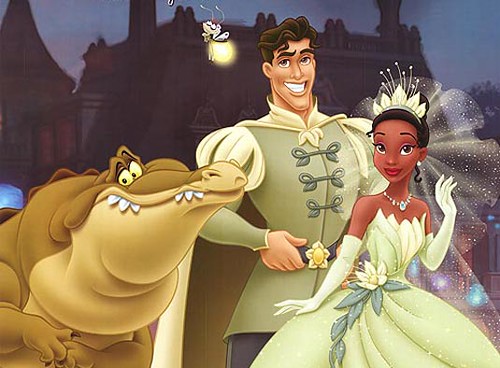Merry Christmas
from the North Carolina Branch of the Haslup Clan
It’s time for another installment of the North Carolina Haslup Clan Obligatory Christmas Letter ™ and, as it happens, here it is. It is written very much in the hopes that it will find you and yours all well and happy, and having a Merry Christmas… or a Happy New Year, or whatever other holiday is timely whenever I finish the letter and get it mailed out.
When I first sat down to write this year’s newsletter I had in mind an approximately chronological presentation and the first thing I realized is that I couldn’t remember much about the first half of the year. There was, mind you, nothing wrong with the first part of the year; we did stuff – the time passed pleasantly enough – but, in retrospect, there wasn’t really much to write home about. I let this problem stump me for an absurd amount of time; I sat there, staring at a blank screen, trying to remember something we did in January or February that would be worth the effort to write down. It was only today, the fourth day in December, with the various postal deadlines for Christmas letters looming, that I realized there was much that was interesting about the year, and I should just do the most interesting thing first, then write about the second most interesting, and so forth until I have filled the space allotted and/or exhausted the patience of my long-suffering readers.

Chris and Reid
Item Number One: A Wedding. The most interesting news for the year by far won’t be news at all for some of you since many of you were there when it happened. Christopher was married October 30th to Reid Clonts – now Jennifer Reid Clonts Haslup – who, for those of you who weren’t at the wedding and don’t know, is a lovely and charming young lady and a very welcome addition to the family. I used all four of her names here in part to tease Reid, who tried to get the Jennifer part dropped when she changed her last name to Haslup, and in part so that, reading this, she can see that it really does make her sound like a princess to have so many names, and is not at all a bad thing. Apparently, changing your last name is easy but changing your first name is hard; it requires hard-to-obtain paperwork which she described to me but I have forgotten – I seem to recall something about a visa signed by General DeGaulle, but perhaps I am remembering something else.
The newlyweds live in an apartment in Raleigh with Reid’s dog Roo (Rue? Roux?) about whom there was some concern leading up to the wedding that, being rather set in his ways he might take a dim view of all the changes of situation that a bride’s dog necessarily faces. But he did much better than expected, even putting up with an extended visit in a household with other dogs while his mistress was away getting married at the Ridgecrest Conference Center in Black Mountain, NC, or was at Disney World, or on a cruise ship off the Mexican coast, or at some other port of call in Chris and Reid’s rather ambitious honeymoon. The apartment (which this paragraph was originally about) is convenient to Christopher’s job at Capstrat where he works as a graphics designer, and to NC State University where Reid is hoping to complete her PhD in Dye Chemistry. In her work for her dissertation she is becoming one of the leading experts on dying things black and on the various color gradations and degrees of blackness of things so dyed. When she receives her degree she hopes to find a teaching position, where she will struggle with the fact that the term “Black Studies” is already in use by a different department.
 |  |
Janet and Irene – Christopher’s and Reid’s respective mothers in laws
A wedding, of course, is the joining of two families and I am pleased to report that Reid’s people and ours seemed to mix without untoward incident at the wedding. Irene and I like Reid’s mom, Janet, in particular. She will fit in nicely with the family, I think. Since she doesn’t know the family that well she may not know what sort of a compliment that is – and neither do I, sometimes – but it remains true.
Item Number Two: Another Wedding. The main thing I am instructed to say about Amber’s upcoming wedding is that it is a really, really small affair and the mailing list for this newsletter runs much longer than the invitation list for the wedding. Amber’s schedule at the Lake Erie School of Osteopathic Medicine (in Bradenton, Florida) has very few breaks for the next several years and those breaks are brief. If she wants to get married (and she does) then this year’s New Year’s break is pretty much it. The wedding is being held on New Year’s Eve morning in a Tampa restaurant that does events and the size of the venue limits the attendees to immediate family and a few local friends. If your invitation fails to arrive you may have been one of the names forced below the line when we belated realized that the bride and groom must be included in our count.
 | 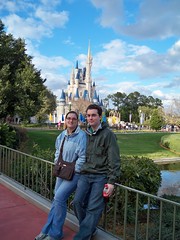 |
Amber and Lee. At Christopher’s Wedding (left) at Disney World (right)
Amber is marrying Lee McPherson who will pass for a renaissance man. He has a PhD in chemistry, has worked as a computer programmer, and is handy with things mechanical. He fixed the transmission on Amber’s PT Cruiser and when he was done they drove it away. It was this last part that impressed me because I too have made repairs to Amber’s various cars over the years but my repairs often ended with the car being towed away with a bag of assorted greasy car parts in a plastic bag on the passenger seat. Since the renaissance man biz is a bit slow right now, Lee is teaching chemistry at a community college in St. Petersburg, Florida, and waiting for a the rebirth of the job market for chemists.
 Lee proposed to Amber while they were visiting the Magic Fountain of Montjuic in Barcelona this past spring as part of a trip to France for Lee’s mother’s and grandmother’s birthdays. The more observant among you will have noticed that Lee and I have the same name and, in answer to the first question that everyone seems to ask: No, we haven’t worked out what we will be called so people can tell us apart. Actually, it’s not hard to tell us apart. Lee has black curly hair, and I have… rather forgotten what sort of hair I used to have.
Lee proposed to Amber while they were visiting the Magic Fountain of Montjuic in Barcelona this past spring as part of a trip to France for Lee’s mother’s and grandmother’s birthdays. The more observant among you will have noticed that Lee and I have the same name and, in answer to the first question that everyone seems to ask: No, we haven’t worked out what we will be called so people can tell us apart. Actually, it’s not hard to tell us apart. Lee has black curly hair, and I have… rather forgotten what sort of hair I used to have.Item Number Three: Everything Else. It’s been a busy year. Lee has been working at Glaxo Smith Kline where he has converted one of their accounting systems to handle multiple currencies. Capstrat is one of Glaxo’s vendors and, since Chris and Capstrat are both in the database, Lee uses them to enter test transactions in the system. Sadly, the test system is not hooked up to the real world and all the business steered Chris’ way is only make-believe. Irene continues to sell cheese at Harris Teeter and to volunteer at the North Carolina Museum of Art. The NCMA has reopened in their much-larger space and Irene and the other docents have been kept quite busy giving tours. Their current big exhibition is the Art of Norman Rockwell which is well worth seeing and runs through the end of January.

Various Cousins (Several Times Removed) from the Copley Reunion
In July we attended a Copley family reunion on Gwynn’s Island, Virginia. We stayed in nearby Gloucester and spent a few hours at the Blackbeard Pirate Festival in Hampton. The reunion was for descendants of my mother’s father’s parents and most of the people there were first and second cousins of some sort. There were lots of kids – they would be cousins once or twice removed. I have included several photos of the event here but I won’t try to identify people in the photos. Many of the ladies looked like their mothers had when last I saw them and, while it is a natural mistake to identify someone you see infrequently as her mom, it never makes anyone happy. It was over supper during the reunion weekend that Amber and Lee, just back from France, announced their engagement. The reunion was quite an event and I am quite grateful for the hard work that several of my cousins did in organizing it.
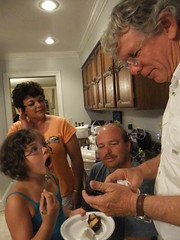 |  |
More Cousins. Eddie Demonstrates the “Mosquito Sounds” Hearing Test App on his IPhone and Assorted Young Cousins Enjoy a Pile of Dirt on the Shore of the Chesapeake Bay.

Dad and I at the Atlantis Resort in Nassau
My next subject is the cruise to the Bahamas that Irene and I took with dad in early September and, as a sort of preamble, I would like to confess that I am totally unable to steer a kayak. Before you all write to tell me that to turn left you either paddle on the right or drag you paddle on the left, or that you can use your paddle as a rudder, let me say that I know all that. It just doesn’t work for me. There is something about the way I hold my paddle, or the shape of my stroke, that allows me to paddle on the right and still turn right, or paddle on the left and still veer left, depending on which side of the boat offers the nearest obstruction for the damnable, unsteerable thing to run into.
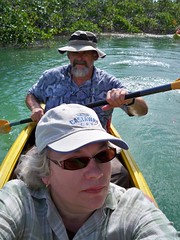 |  |
Kayaking Through a Mangrove Marsh on Grand Bahama Island
That said, if you are ever looking for an excursion on Grand Bahama Island, you might consider the Lucayan National Park Kayak and Cave Tour. The first leg – kayaking through a mangrove estuary – is one of the highlights of the trip. It includes stops where the guide pauses and all the boats gather around while he tells interesting and amusing things about the mangrove marsh. For details of this part you would have to ask dad, who was in the boat with the guide. Irene and I were busy at the time zigzagging our two man kayak back and forth across the narrow channels behind them, giving the mangrove roots a much closer, hands-on inspection as we ran into them. All I remember the guide saying at the stops in the mangroves was “Ah, they’ve caught up. We can go on.”
The tour also includes a gourmet lunch -- ok, bologna on white bread, cheap packaged cookies, apples and powdered lemonade, but after a morning of wrestling with mangrove roots it was pretty tasty, and they did have some guava jam which gave it some Bahamanian flair -- plus a guided nature walk, an hour at a really nice beach and a tour of two “caves” which, National Geographic will tell you, are some of the most extensive in the world. Of course, nothing on Grand Bahama being that far above sea level the caves are almost entirely underwater, but you do get to see quite a nice hole in the ground with stairs you can descend (about 30 feet) to water-level.

Dad and Irene Climb the Stairs out of the “Cave”

In January… [yes, I have remembered January …] Irene made her annual trip to Disney World with her former co-workers from the time when she worked at the Disney Store. Amber and Lee came over and spent one day with her in the park. Shortly after her return to NC, her car was involved in one of the showiest parking lot car accidents I have ever seen. A woman who had been drinking ran into a car in the parking lot at Harris Teeter -- and then she tried to flee the scene, running into Irene’s car plus six more cars and a shopping cart corral in the process. Her demolition derby show took place in the employee area of the parking lot and the most of the cars she hit belonged to Irene’s coworkers. No one was hurt in the accident but of the nine cars involved Irene’s was the least damaged at slightly more than $2000 in repairs (for which the woman’s insurance paid.)
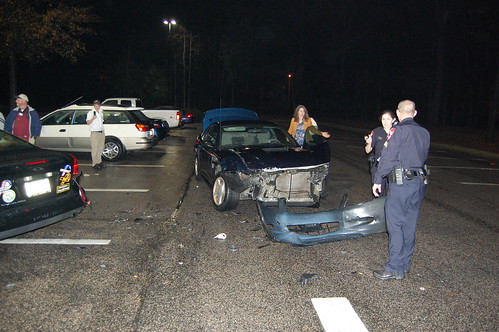
Irene’s car is the white Subaru wagon on your left.
Miscellaneous Photos:

Breakfast in Gloucester Va.
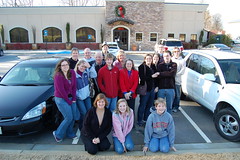 | 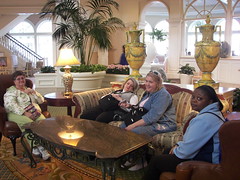 |
Family Photo in Atlanta Last Dec. Irene’s Fellow Disney Store Expatriates.

Irene and Her Cousin Lorrie At Ridgecrest














